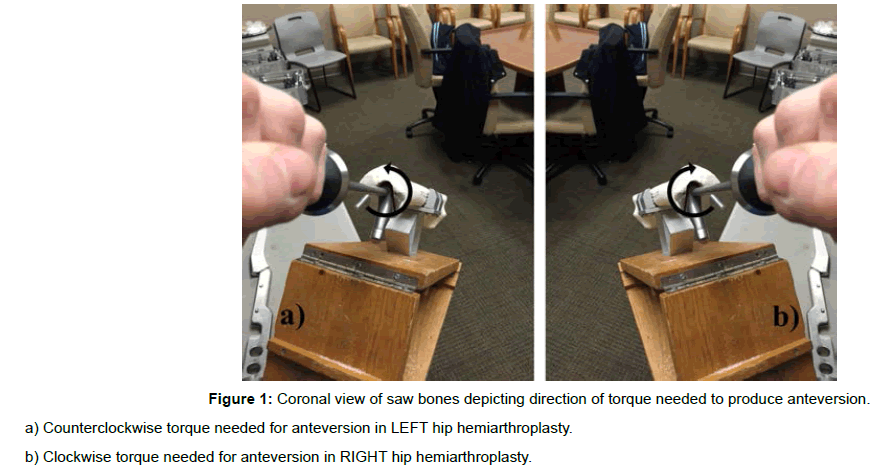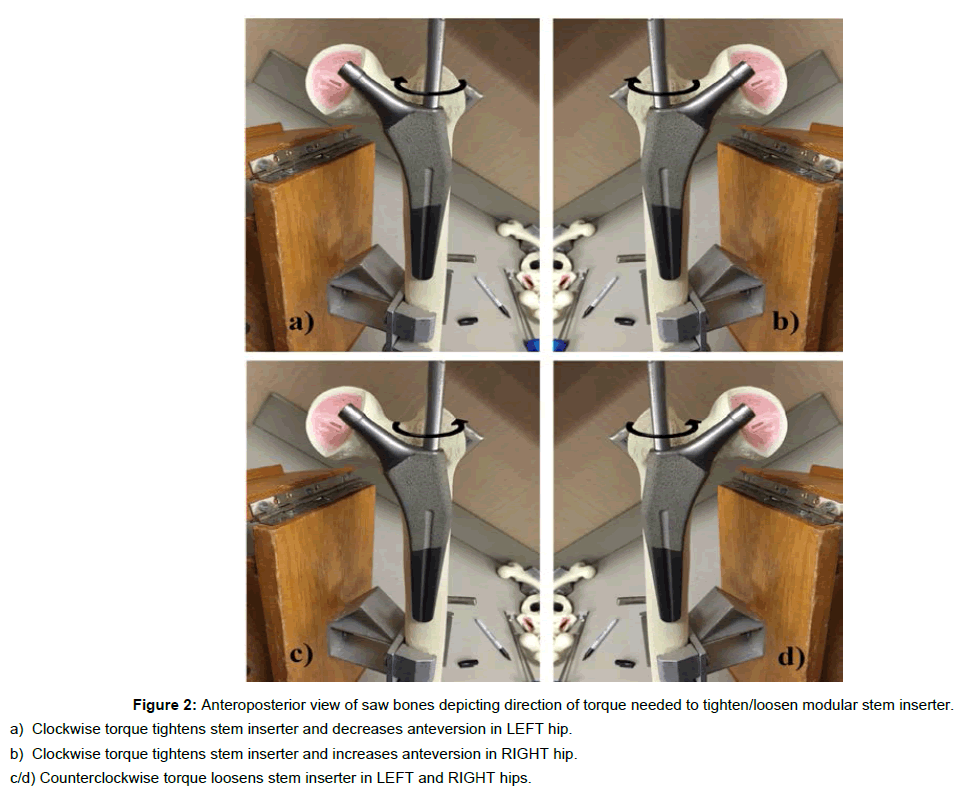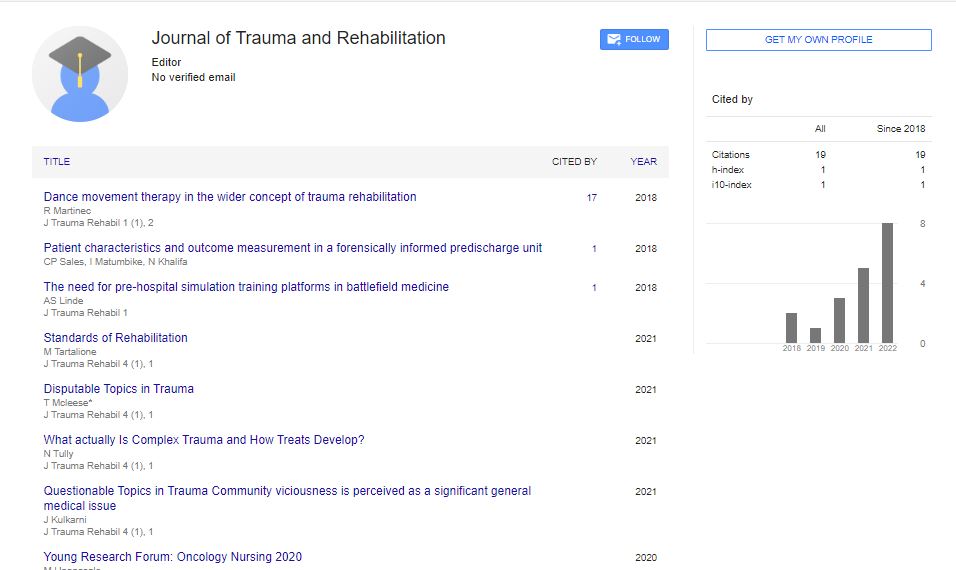Research Article, J Trauma Rehabil Vol: 1 Issue: 1
Loss of Anteversion in Left Sided Hemiarthroplasty with the Use of Modular Threaded Inserters
Ebraheim N, Stirton J, Andrews K and Lu A*
Department of Orthopaedic Surgery, University of Toledo Medical Center, Toledo, OH, USA
*Corresponding Author : Alex Lu
Department of Orthopaedic Surgery, University of Toledo Medical Center, Toledo, OH, USA
Tel: 4195095372
E-mail: alex.lu2@rockets.utoledo.edu
Received: October 17, 2017 Accepted: January 03, 2018 Published: January 12, 2018
Citation: Ebraheim N, Stirton J, Andrews K, Lu A (2018) Loss of Anteversion in Left-Sided Hemiarthroplasty with the Use of Modular Threaded Inserters. J Trauma Rehabil 1:1.
Abstract
Appropriate restoration of the native femoral anteversion is important for achieving stability of the joint in hemiarthroplasty and total hip arthroplasty. Anteversion of the femoral component is obtained differently in a right versus a left hip; clockwise torque is required on the right while counterclockwise torque is required on the left. Counterclockwise torque on a threaded inserter of the femoral component on a left sided hemiarthroplasty causes loosening of the inserter into the femoral component and translates to a possible loss of anteversion during insertion. The author suggests an acute awareness of this phenomenon when preparing the femur in a left-sided hemiarthroplasty so that appropriate attention and care can be maintained during this step.
Keywords: Hemiarthroplasty; Rotation; Complication; Anteversion; Torque
Introduction
Femoral neck anteversion is a natural torsion that is present in the femur. It is thought to develop during limb bud development, when there is internal rotation of the femur, otherwise known as medial femoral torsion. This creates an angle between the femoral condyles plane (bicondylar plane) and an imaginary plane passing through the center of the femoral head and neck. Anteversion is described when the bicondylar plane is found behind the plane passing through the center of the femoral head. This angle, which starts at 31-40 degrees in children and decreases to between 15-20 degrees in adults, is considered normal femoral anteversion [1,2].
When there is an abnormal femoral anteversion, various problems may result in the native joint. A decrease in femoral anteversion is thought to be a risk factor for developing a slipped capital femoral epiphysis [3]. The development of osteoarthritis of the hip is also associated with a decreased femoral neck anteversion. This could be due to the abnormal stress placed on the acetabular labrum and cartilage with decreased femoral anteversion. This phenomenon has been shown in biomechanical models that demonstrated increased joint peak pressures on cadaveric hips when the natural femoral anteversion was modified into retroversion [4].
In hip hemiarthroplasty, restoration of femoral anteversion is paramount. Studies have shown that decreased femoral anteversion is a risk factor for bony impingement after bipolar hip hemiarthroplasty procedures. Impingement is a major cause of post-surgical instability of the joint, and can lead to dislocation due to impingement between the anteriorinferior edge of the iliac spine and the anterior greater trochanteric region of the femur. Furthermore, due to this impingement, there is a decrease in the range of motion of flexion and internal rotation of the joint when normal femoral anteversion is not maintained [5].
An awareness of the potential pitfalls regarding any operative case or instrumentation is essential to the practicing orthopedic surgeon. One such pitfall will be described here for the case of left-sided hemiarthroplasty with the use of modular threaded inserters. In this case, there is a potential loss of femoral anteversion due to loosening of the inserter from the femoral component.
Surgical Technique/Discussion
The consequence of misdirected rotational torque has been described elsewhere - specifically in regards to the effects of clockwise torque on right and left-sided dynamic hip screws in intertrochanteric hip fractures. That study found that rotational torque imparted in the sagittal plane during screw insertion can lead to a potentially unstable construct in left-sided DHS fixations when compared to the rightsided ones. In right-sided fractures, the rotational torque often causes compression of the head and neck fragment into the distal fragment with the creation of an infero-medial buttress, whereas the rotational torque imparted to the proximal head and neck fragment in leftsided fractures caused loss of reduction leading to the anterior spike deformity [6].
It has been our observation that a potential pitfall of leftsided hemiarthroplasty is a loss of anteversion when inserting the femoral component secondary to the unintentional effect of the counterclockwise torque necessary for increasing anteversion. This counterclockwise torque, intended to restore the femoral anteversion, instead loosens the inserter from the femoral component thus limiting the amount of anteversion that can be applied. A similar effect is obviously avoided in right-sided hemiarthroplasties because the clockwise torque required to restore anteversion of the femoral component on the right side only serves to tighten the inserter into the femoral component.
The intraoperative estimation for femoral stem anteversion is generally performed by measuring the angle between the long axis of the neck and the condylar axis of the distal femur [7]. This is typically between eight and 14 degrees. Anteversion of the femoral component is set during the broaching process. Thus it is not only important to select the appropriate anteversion with the first broach, but it is important not to toggle the broach during this process as this can lead to a loss of axial alignment and thus a poor fitting femoral component [8].
An inserter is used to position the femoral component during impaction. Systems with a modular threaded stem inserter have the potential pitfall of losing anteversion in a left-sided hemiarthoplasty. During insertion of the femoral component, any counterclockwise force directed on the inserter, and thus the femoral stem, to restore anteversion will result in loosening of the inserter from the stem itself (Figure 1). Thus, it is of extreme importance that the surgeon broach to the appropriate anteversion as no more can be applied with the insertion of the femoral component. This is not the case in right-sided hemiarthroplasties with the same system. Here, one may apply clockwise torque to the inserter which will fully translate to anteversion of the femoral component during insertion (Figure 2).
Figure 2: Anteroposterior view of saw bones depicting direction of torque needed to tighten/loosen modular stem inserter.
a) Clockwise torque tightens stem inserter and decreases anteversion in LEFT hip.
b) Clockwise torque tightens stem inserter and increases anteversion in RIGHT hip.
c/d) Counterclockwise torque loosens stem inserter in LEFT and RIGHT hips.
Conclusion
Awareness of the fact that counterclockwise torque on the threaded inserter of the femoral component on a left sided hemiarthoplasty causes loosening of the inserter into the femoral component (Figure 2), and translates to a possible loss of anteversion during insertion, will allow the surgeon to make the appropriate adjustments necessary to avoid this outcome. By being conscientious in regards to this observed phenomenon, multiple detrimental consequences for the patient, such as joint instability due to bony impingement, increased risk for joint dislocation, and decreased range of motion on flexion and internal rotation, can be avoided.
References
- Karnezis I (2001) A technique for accurate reproduction of the femoral anteversion during primary total hip arthroplasty. Arch Orthop Trauma Surg 121: 343.
- Cibulka MT (2004) Determination and Significance of Femoral Neck Anteversion. Physical Therapy 84: 550-558.
- Galbraith RT, Gelberman RH, Hajek PC, Baker LA, Sartoris DJ, et al. (1987) Obesity and decreased femoral anteversion in adolescence. J Orthop Res 5: 523-528.
- Satpathy J, Kannan A, Owen JR, Wayne JS, Hull JR, et al. (2015) Hip contact stress and femoral neck retroversion: A biomechanical study to evaluate implication of femoroacetabular impingement. J Hip Preserv Surg 2: 287-294.
- Shoji T, Yasunaga Y, Yamasaki T, Izumi S, Hachisuka S, et al. (2015) Low femoral antetorsion as a risk factor for bony impingement after bipolar hemiarthroplasty. J Orthop Surg Res 10: 105.
- Mohan R, Karthikeyan R, Sonanis SV (2000) Dynamic hip screw: does side make a difference? Effects of clockwise torque on right and left DHS. Injury Int J Care Injured 31: 697-699.
- Harkess JW (1998) Arthroplasty of the hip. In: Canale ST, editor. Campbell’s operative orthopaedics. St. Louis: Mosby P 296.
- Stryker accolade ii femoral hip system: Surgical Technique.
 Spanish
Spanish  Chinese
Chinese  Russian
Russian  German
German  French
French  Japanese
Japanese  Portuguese
Portuguese  Hindi
Hindi 

